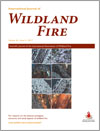International Journal of Wildland Fire
Volume 26
Number 4 2017
Historical fire–climate relationships suggest three fire regimes: flammability-limited, fuel-limited and ignition-limited ecosystems. In the first, annual burning is limited by seasonal climates; in the second, by climate factors that affect herbaceous fuel production; and in the third, the patterns are more strongly controlled with human ignitions than with annual variations in climate.
Interannual variability in burn severity across forested regions of the western United States is found to be weakly to moderately correlated with fuel aridity, moisture stress and burned area extent. These results suggest that increased fuel aridity resulting from anthropogenic climate change will increase burn severity in western US forests.
Historical wildfire occurrences were mapped using remotely sensed data to analyse the spatial and temporal patterns of forest fires in Nepal since 2000. These data were supplemented with a modelling procedure to compute and map fire risk within Nepal’s 75 districts. The risk maps will potentially aid firefighting authorities to allocate limited resources to areas where the potential fire risk is highest.
In savanna ecosystems, recently burned areas attract large number of herbivores, but we know little about how long such attractiveness may persist. By monitoring herbivores’ visitation of burns over a period of 6 years, we found that long-term preference for the burns varied predictably depending on the herbivore species and the spatial scale (extent and grain) of the burn. These results highlight the importance of considering spatial scales in implementing fire prescriptions.
Forest fires are a major source of C, N (important greenhouse gases) and Hg (important pollutant) to the atmosphere. Using a new remote sensing scaling approach, we found that >90% of those elements in the forest floor were emitted to the atmosphere during a wildfire in northern Minnesota.
For the first time, we have coupled the use of field observations of burn severity with charcoal reflectance for four tussock–shrub Alaskan tundra wildfires. Reflectance results suggest that heating durations were broadly similar across the burns and microsite variations in burn severity were due to local variations in fuel moisture.
We predict firebrand transport and landing position using a transport model that explicitly includes plume turbulence. The in-plume turbulence largely determines the spread in landing position, and also approximately doubles the maximum spotting distance compared with that in a plume without turbulence. These results provide a pathway to better parametrisation of firebrand transport.
A coupled atmosphere–fire model was used to investigate the dynamic fire spread that occurs when two firelines merge at an oblique angle. The results agree qualitatively with a previous experimental study, and give insight into the pyro-convective processes that help drive this form of dynamic fire behaviour.




